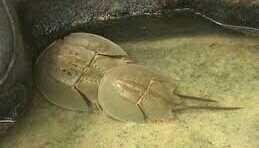#662 [Horseshoe horseshoe animal crab shaped like a helmet with its long tail has saved man with his blood.]
An animal known for its toxic sting is much less known to kill humans in just seconds, usually feared. But nowadays, these venomous animals turn out to be cattle due to the advances in technology so that the researchers managed to find something that is very valuable in the content of animal poison. The need for this will increase as the number of benefits of this animal toxicity increases. Thus making the price of this can be very expensive because of the scarcity of material and hard to get this poison toxin.
The following
 )
)
During World War II, treatment was as dreaded by enemy bullets, unhygienic conditions and equipment making wounds and diseases of the breeding field of bacteria. But this problem has been handled by the "blue blood" of this unique crab. Crabs that live in shallow waters is very risky bacteria infected in the sand. The amebocyte cells contained in the blood will identify and catch bacteria that prevent it from developing.
This discovery has been used on a large scale worldwide. Every year 600 thousand crabs are captured and as much as 30 percent of its blood is extracted by various facilities in the United States and Asia. The extract is sold for US $ 60 thousand or around Rp 703 million per gallon in a global industry worth US $ 50 million or Rp 500 billion each year. In other parts of the world this blood is also used for other functions. Japanese scientists have designed a test for fungal infections with this blood.

Other studies have also developed this blood for antiviral and anticancer treatment through the same principle of isolating bacteria. Other developments use different methods to identify toxins and bacteria, one of them by using an electronic chip that will be wary of possible contamination. There is another invention from the University of California using liquid crystals as a detector similar to cheaper drug prices.
However, this development has not been passed by the United States Agency for Food and Drug Administration as another alternative. The urgency of other findings besides blue blood is higher when there is a decrease in the number of crabs. In the last 15 years the number of horseshoe crabs has been reduced by 75 percent and 90 percent in its largest population in the Bay of Delaware. Although after harvesting these crabs are returned, but in the extraction process as much as 10-30 per cent of crabs die in the process.
Howdy partner, I'm @photocurator, a curation bot; I keep an eye on the photo feeds, I vote random photos of my followers and at the end of the day I publish a post with links to the best photos. Follow @photocurator to get your photos curated in the future!